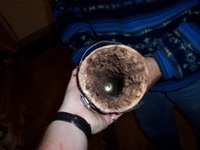Agave didgeridoo work
 I had a grand old time Sunday. Yes, that's a power saw. Yes, that's my hand. No, nobody got injured- or involved with the law.
I had a grand old time Sunday. Yes, that's a power saw. Yes, that's my hand. No, nobody got injured- or involved with the law.
I spent about five hours working with Steve from the Oztin Didjgroup on the agave stalk that I previously recovered. He's got an actual house with a garage and power tools, and he very graciously allowed me to make use of the gear. Not to mention the experience in doing this sort of thing before. We wound up basically just cutting it in half-ish and removing the pith from the center of both stalks. Because the original stalk had laid out for so long, it had nearly dried completely, making for relatively easy going.
Agave smells very much like sugarcane with a hint of something spicy, or maybe cedar or sandalwood.
If you think of an agave stalk as a carrot standing on its thick end, imagine cutting it just south of middle. I wound up with one longer and thinner proto-didj and one shorter and fatter proto-didj. The longer one measures about 82 inches long with a two-and-a-quarter-inch mouthpiece and a three-inch bell, whereas the shorter measures 70 inches long with two-and-three-quarter-inch mouthpiece and a four-and-a-half-inch bell. Roughly, of course- look at my timestamp. Steve thinks that the longer one will sound deeper than the shorter one. Honestly, the physics of the didgeridoo are insane, and I'm not one to question. Termites or grubs or something had gotten to the end of the stalk, eating out the center. This is how real traditional eucalyptus didgeridoos are made and is extremely unusual for an agave didj to be hollowed out this way, even partially. Once I seal the stalk, I expect the irregular surface will make for some extremely interesting sound.
Termites or grubs or something had gotten to the end of the stalk, eating out the center. This is how real traditional eucalyptus didgeridoos are made and is extremely unusual for an agave didj to be hollowed out this way, even partially. Once I seal the stalk, I expect the irregular surface will make for some extremely interesting sound. The next step is for me to obtain the requisite Bondo Marine epoxy resin, wait for warmer weather, and seal these babies. Home Despot alleges they've never heard of the stuff. The quest continues!
The next step is for me to obtain the requisite Bondo Marine epoxy resin, wait for warmer weather, and seal these babies. Home Despot alleges they've never heard of the stuff. The quest continues!
Some extra pictures: The thinner of the two stalks (right) next to the drill (left) used to clean it out. That's four feet of extensions plus a wire brush attachment, incidentally.
The thinner of the two stalks (right) next to the drill (left) used to clean it out. That's four feet of extensions plus a wire brush attachment, incidentally. Keeping splits in check with some pipe clamps.
Keeping splits in check with some pipe clamps. Brushes, tools, bits, and bobs. Start with a paddle bit to do most of the grunt work, then move to using the wire brushes to abrade the pith away, leaving the hardwood intact. The walls of the agave are very light and relatively strong- sort of like aluminum of the desert plant world.
Brushes, tools, bits, and bobs. Start with a paddle bit to do most of the grunt work, then move to using the wire brushes to abrade the pith away, leaving the hardwood intact. The walls of the agave are very light and relatively strong- sort of like aluminum of the desert plant world. This picture shows the LED flashlight bringing the termite grooves into relief. I think this looks really cool. Some of the other shots turned out much blurrier- I'm still working on grokking basic light writing- er, photography.
This picture shows the LED flashlight bringing the termite grooves into relief. I think this looks really cool. Some of the other shots turned out much blurrier- I'm still working on grokking basic light writing- er, photography.





3 comments:
Coolers make great saw tables : )
thanks for the help..but i have a small question..how do you seal them???with epoxy?how's the process?i would be very thankfull if you answer this questions...i am in the exact some position...2 agaves...one smaller larger...and one thiner and longer...by the way..i must wait for them to dry, isnt it?
BIg hug
Namasté
I just landed a huge agave stem, maybe 25 feet long. If I have 12 feet of drill bit extension, and a wire brush like you had at the end, can I actually ream out the inside of this thing, first from one end, then the other? What inside diameter do you recommend? This would create a huge Tibetan horn-type instrument. Or a world record didge. What do you think?
Post a Comment